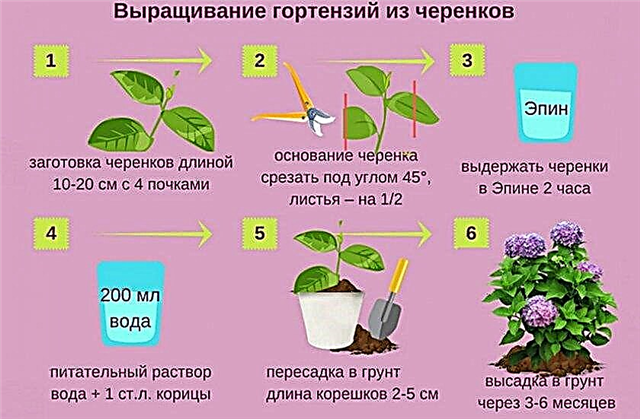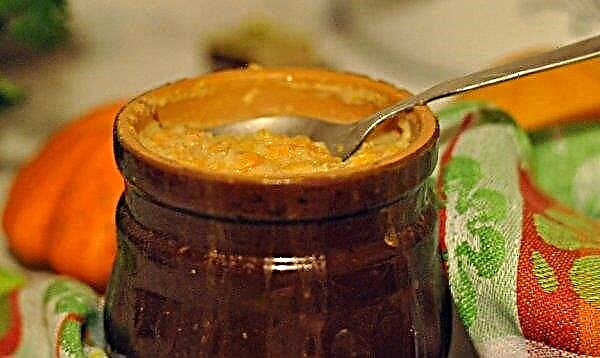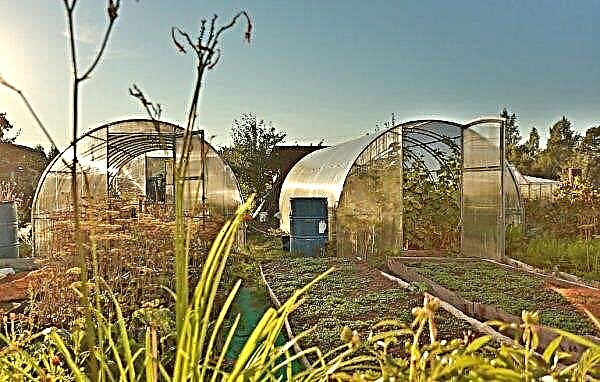Florists love hydrangea for their unpretentiousness, long flowering and the ability to change the color of petals in different soils. This article is a story about panicle hydrangea Grandiflora (Hydrangea paniculata Grandiflora).
Hydrangea Grandiflora in landscape design
A tree-like deciduous shrub grows to 2.5 m in height and a crown diameter of 3 m. Next to the Grandiflora variety, given its growth, you can plant bushes, dwarf trees and tall flowers or grasses. Organically, against the background of large 30 cm long pink and white pyramids of hydrangea inflorescences, small white flowers with long stamens and then bright red viburnum fruits will look first. The flowering period of the variety is from July to October. The combination of Grandiflora and spirea of bright colors, for example, purple Japanese or lilac-pink Billard, is also beautiful.
A blooming culture against the background of conifers will be a bright accent:
- thuja;
- juniper;
- cypress (species Japanese, North American);
- fir (Korean).

Well adjacent to hydrangea roses and carnations of high species. Different types of perennials are planted with a plant in the group:
- miscanthus (blooms with pearl-purple ears);
- hibiscus with purple small inflorescences;
- Canadian goldenrod (yellow miniature baskets);
- Buzulnik (bright yellow stars 10 cm in diameter);
- cornflower of Delaway and Helidon (lavender-type flowers);
- Veronikastrum virgin with needle long lilac inflorescences.

Grandiflora in landscape design is used for planting hedges. It is tall, with a dense crown and large leaves up to 15 cm in length. Such a fence will reliably hide from prying eyes. And lush pyramidal inflorescences, stuffed with small, first cream, then white, and at the end of flowering pink flowers, will give the hedges an elegant look.
How to plant
The first flowering in the variety occurs on the 4th – 5th year after planting. For it to be long and lush, the plant needs to be provided with suitable conditions. Choose a place, prepare a site. Panicled hydrangea will develop well on moist and loose soils with an acidic and slightly acidic reaction. The variety can be grown as a shrub or tree.
Did you know? Panicled Grandiflora was the first species discovered by Europeans in 1768 on the island of Mauritius. At that time, the height of the bush in the garden reached 10 m.
Landing time
In the southern regions, the plant is planted both in spring, in April - May, and in autumn in September - October. In the central and northern regions, spring planting is recommended. In the fall of hydrangea, there is not enough time to take root, early frosts will destroy it. When planting, the soil should be warmed up to + 8 ... + 10 ° С. It is best to choose a time when the weather is already stable and there is no threat of return frosts.
Seat selection
Delicate petals do not tolerate the aggression of the active sun. It is advisable at this time to shade the shrub using the screen or choose a place with natural partial shade. The root system of the plant is located close to the surface, therefore, for planting a tall bush or tree, a flat garden surface is desirable. Wind protection is also important, with strong gusts that can break branches.

Selection and preparation of planting material
Seedlings are best purchased at trusted garden stores or nurseries. A healthy plant has a moist root system with flexible shoots. There should be no stain or smell of mold. On the central stem there are 2-3 shoots with well-developed internodes. Before planting, the roots are soaked for half an hour in water with the addition of potassium permanganate, which will serve as a prophylaxis against fungal diseases.
Landing
The site needs to be dug up and cleaned of vegetable debris. A pit for a seedling is prepared with a size of 50 × 60 and 60 cm deep.
Landing pattern:
- At the bottom of the hole, drainage is laid with a layer of 10-12 cm.
- The nutrient mixture is prepared from garden soil, compost, peat and turf soil in a ratio of 1: 1: 2: 2.
- Half of the mixture is placed on top of the drainage in the form of a hill 15 cm high.
- Having placed a seedling on a hill, sprinkle it with soil. The root neck remains above the ground.
- After being watered, spending a bucket of water.

How to care
Grandiflora loves moist soil and responds well to fertilizers. Nutrients and moisture are needed for the growth of shoots, laying buds and long flowering. The bush grows rapidly: the annual growth of branches is 25 cm. This feature requires regular cutting.
Watering
According to the description of the biological characteristics of the variety, it is resistant to short-term drought. But a lack of moisture even for a short period of time can degrade the quality of flowering. The bush is watered once a week, spending up to 2 buckets of water.

The procedure is carried out in the early morning or evening, it is advisable not to wet the foliage. If the weather is hot, rainfall is scarce or absent, watering is needed twice a week. If it rains a lot, they are plentiful and long, watering is carried out only when necessary.
Important! Roots of plants located close to the surface may undergo fungal infection due to waterlogging.
Top dressing
The large-leaved species of Gridrangia needs feeding 3-4 times a season. Fertilizers contribute to the growth of shoots, foliage and the formation of buds. When using dry mineral compounds, the earth must first be moistened so as not to cause burns to the roots.
Feeding scheme:
- After snowmelt, before swelling of the kidneys, fertilize with a solution of mullein 1:15 or bird droppings 1:20. Infusion is poured under a bush, 2 buckets for one instance.
- During the formation of buds, an aqueous solution of mineral fertilizers is used: ammonium nitrate 20 g, potassium salt and superphosphate 30 g / per 10 l of water.
- In mid-July, the Fertika drug is used: a granular agent is embedded in the soil of 50 g / m².
- At the end of August, 50 g of potassium salt and superphosphate are introduced into the trunk circle.

Mulching
The use of mulch performs several important functions in care:
- moisture retention;
- root protection from overheating or hypothermia;
- the soil content is clean (does not allow weeds to develop).

As a shelter use any natural material: peat, straw or mowed grass, sawdust or pieces of wood bark. A good option for hydrangea as a mulch would be fallen needles: in addition to the main purpose, the material acidifies the soil.
Pruning
Pruning an adult plant is carried out every year. The variety is fast-growing, the thicker the crown, the smaller and less inflorescences. Shoots are cut to 2-3 buds, remove weak and thin, damaged by wind or frost.
Did you know? According to an ancient Japanese legend, on the birthday of Buddha, beautiful flowers fell from the sky, they were called Adzisai (sunny flower). In Europe, the plant was called hydrangea.
To form a plant in the form of a tree, at the young age of 4–5 years, all shoots are cut at the very base, leaving one of the strongest. To rejuvenate, the bush is cut to a stump, next year a young strong shoot will appear.

Winter preparations
An adult shrub or tree does not need shelter. In cold regions, you can only put protection against the wind and cover the trunk circle with mulch 25-30 cm. In winter, remove snow from the branches so that they do not break under the weight of the infusion. Stakes are driven around a young plant, covered with agrofibre and spruce branches on top. Pre-mulch the trunk circle.

Pest Management and Prevention
Grandiflora is one of the disease resistant varieties. However, insect attacks and disease damage occur.
Common growing difficulties and measures to overcome them:
- Powdery mildew, root rot, septoria. The drug "Allirin-B" - 2 tablets per 10 liters of water, water the plant.
- Spotting, tracheomycosis, bacterial cancer. Spraying with the fungicide “Diskor”, a solution in the proportion of 5 ml / 10 l of water.
- Aphids, penny butterfly, scoop. "Akarin" for spraying, a solution in a dosage of 6-8 ml / 1 l of water.
- Nematode, slugs, weevil. Insecticide "Apache", a solution for irrigation in a proportion of 1 g / 1 liter of water.

A number of simple actions will help prevent a gardener from developing diseases:
- Cleansing the soil from previous vegetation.
- Disinfection of seedling roots before planting.
- Compliance with irrigation and top dressing.
- Maintaining the purity of the trunk circle.
- Spring preventive treatments with a Bordeaux mixture of 1%.
These measures are also suitable for the prevention of insects. Additionally, around hydrangea, you can plant repellent plants that repel pests with their pungent odor, for example:
- sagebrush;
- marigold;
- tansy.
Broader nut shells or crushed egg shells will hold back from creeping on culture.

Hydrangea propagation
Deciduous hydrangea at home easily reproduces exclusively vegetatively. Ways:
- Dividing the bush. In the spring, before the buds swell, a part of the root with branches is carefully separated from the donor bush and transplanted to a new place. Care for the delenka is the same as for adult culture.

- Cuttings. For propagation from current shoots, a branch of 5–7 cm is cut at an acute angle at the beginning of summer. They are planted in a greenhouse in a moist mixture of sand and peat in equal proportions. Cover with a cropped plastic bottle. The substrate is kept moist, once a day they remove the shelter and ventilate for 15–20 minutes, and condensate is removed from the walls of the plastic. Transplanting to a new place next spring.

- Layering. A furrow of 15 cm deep is dug under the longest branch at the base of the bush. A selected shoot is laid in it, placing a piece of land cleared from foliage in the ground. Nailed with staples. Above the surface there remains an apex of 15–20 cm. Leaving - just like after the mother bush. Change to next spring.

A decorative plant will decorate any part of the garden. Shrub is not difficult to grow, it is perfectly adjacent to a large list of garden crops.















